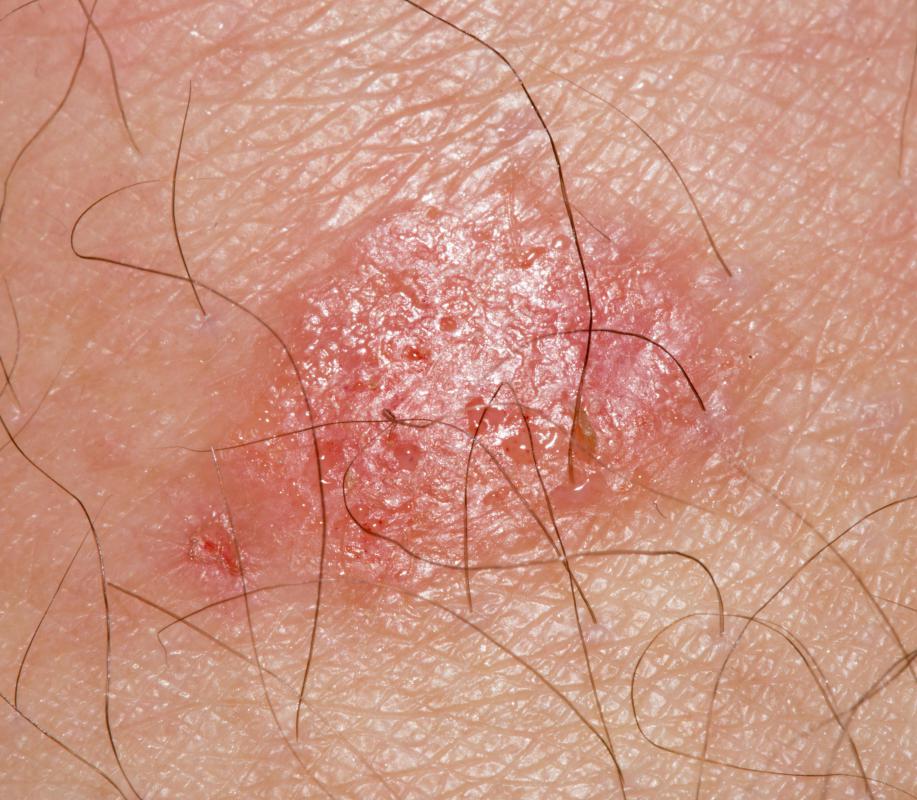At TheHealthBoard, we're committed to delivering accurate, trustworthy information. Our expert-authored content is rigorously fact-checked and sourced from credible authorities. Discover how we uphold the highest standards in providing you with reliable knowledge.
How is Ringworm Treated?
Ringworm is not, as the name implies, an infection caused by worms. Rather it is a fungal infection of the skin that can occur in various places—on the head, under the arms, in the groin area, and on the feet. The proper name for ringworm is tinea, and it is an infection that can be passed to other people. This is why treatment of the condition is important. Lack of treatment can cause this type of tinea, which often appears in ringed patches, to spread.
There are essentially a couple of ways to treat ringworm, and treatment may depend upon the extent of infection. For many, a small patch is treated with a topical lotion that contains an anti-fungal agent. There are several anti-fungals that may be used: clotrimazole, miconazole, ketoconazole, and terbinafine. Occasionally these are purchased over the counter, but you might need a prescription for a higher strength preparation.

Using lotions is usually the first line of treatment for minor cases of ringworm, but it may be ineffective if the area of fungal infection is large or growth is advanced. Further, some cases of tinea just don’t respond very well to lotions. Fungal infection around the nails for instance may not be adequately treated, and if it is under the finger or toenails, it’s almost impossible to get lotion to the areas.

When lotions have failed, or are impractical for use, people may be prescribed certain anti-fungal medications to take orally in order to kill fungus. These are basically of three types: griseofulvin, itraconazole, and fluconazole. In the past, some fear existed that these internal treatments could damage the liver. The medical community has disproved this and these medications are safe to take in most cases. They can cause some unpleasant side effects including stomach upset, hypersensitivity to the sun, and fatigue.

As with treatment with antibiotics, it’s very important to take the medication prescribed for ringworm exactly as directed. Stopping before you finish the full course can result in a stronger backlash fungal infection that makes matters worse. If your infection has cleared prior to ending the medication, you should speak with your doctor about whether it is safe to stop taking meds.

You can also do some things at home to help speed recovery from ringworm. For instance keeping the affected area dry is important, since fungus tends to thrive in moist environments. Towel off fully after showering, or even use a blow dryer on a cool setting to make sure the skin remains dry. If you get sweaty during the day, pat dry the infected areas every couple of hours.
Since you can give ringworm to others, don’t share towels, makeup, or deodorant, wear shower shoes in the shower, and consider keeping the area of infection covered when possible.
AS FEATURED ON:
AS FEATURED ON:
















Discussion Comments
My sister got ringworm on her arm a few years ago. She tried putting stuff on it, but the place kept getting bigger. She kept messing around with it and it was the size of a half-dollar when she finally went to the doctor with it. The doctor diagnosed ringworm, and also said my sister had started with it at one corner of her mouth, where she had transferred the fungus!
She had to get some prescription ringworm treatment and used the whole tube to get rid of the stuff completely. It took about six weeks for it to go away totally. Her doctor fussed at her for leaving it so long before she came in to have it looked at. Of course, my sister has five cats, so there's no doubt at all how she got the ringworm to start with. It's kind of inevitable.
Some people think you get ringworm from being dirty, but that's not the case. If you have a cat or dog, you can get it. You just have to treat it in a timely fashion.
Years ago, I had a scaly, itchy patch on my back, right above my waistline. I couldn't really see it in the mirror, so I got a friend to look at it for me. Sure enough, it was ringworm. My friend said the place was perfectly round and looked red and scaly, so I knew right then it was ringworm. The standard anti-fungus cream from the drugstore healed it right up. It was better the day after I started putting the cream on it.
It was still better than athlete's foot, which is the most horrible itching I've ever had! Never want that stuff again.
Post your comments